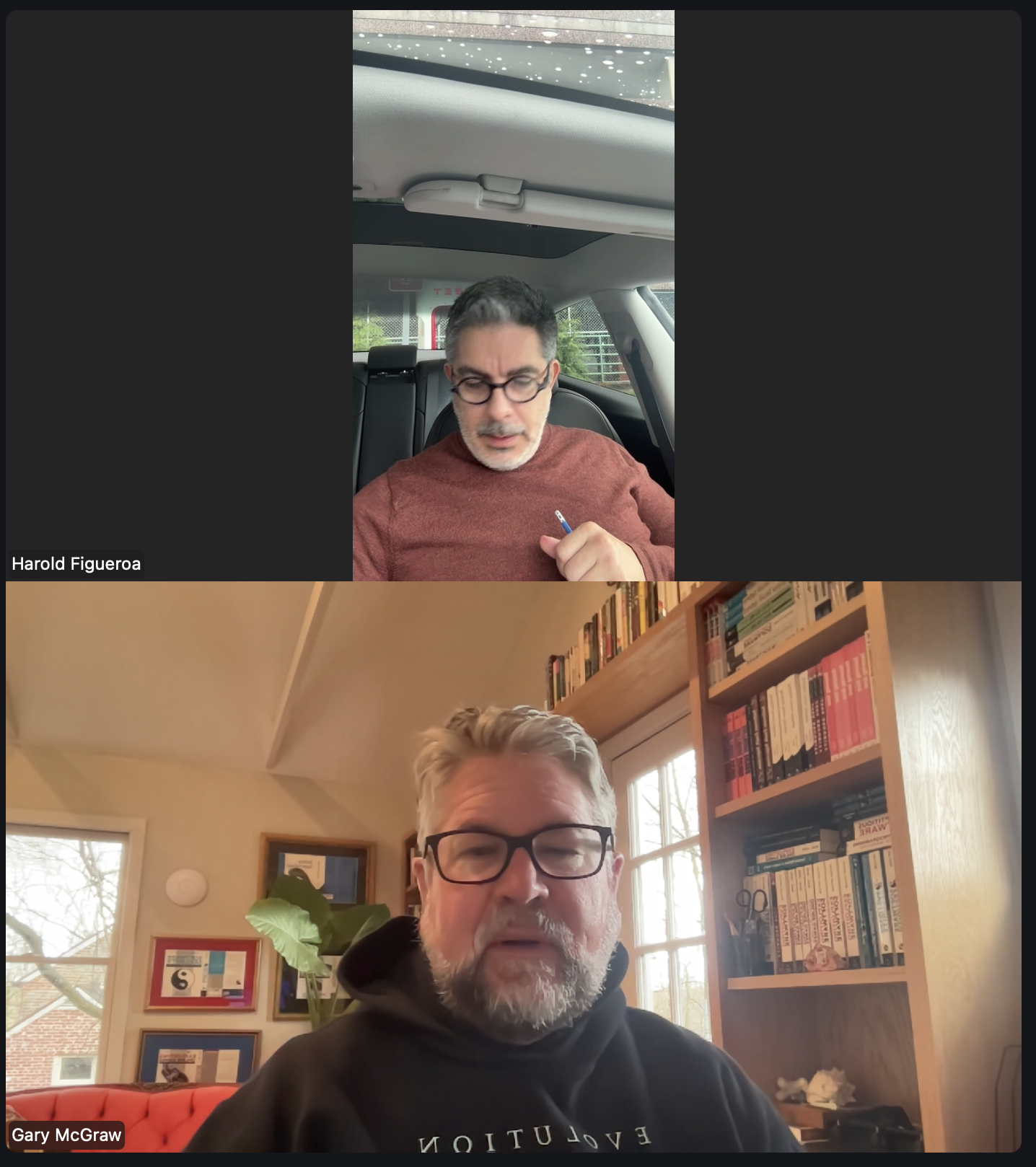Gary McGraw’s pre-Cigital publications from CRCC/FARG
My PhD thesis — Letter Spirit (part one): Emergent High-level Perception of Letters Using Fluid Concepts.
Chapter
- Fluid Concepts and Creative Analogies
Chapter 10, Letter Spirit: Esthetic Perception and Creative Play in the Rich Microcosm of the Alphabet
Refereed publications
Sadly, some of these papers no longer seem to be available anywhere. This is a testament to the ephemeral nature of the web. RIP papers.
Gary McGraw and David Hovemeyer. (1996) Untangling the Woven Web: Testing Web-based Software Proceedings of the 13th International Conference and Exposition on Testing Computer Software (ICTCS), June 10-13, 1996. pp 111-119, Washington, DC.In the early 90’s, public interest in the Internet skyrocketed with the introduction of web browsers and hyper text markup language (HTML). As the world-wide web becomes more commercial and people start using browsers to purchase products and do other business, issues of website testing become more and more critical. In addition to web-based commerce, Intranets have also recently become a hot topic. This paper focuses on three general issues in web testing that are applicable to all web-based products: 1) automating remote testing of websites, 2) developing software assessment techniques for Java applets, and 3) issues in website security.
Aaron S. Binns and Gary McGraw. (1996) Building a Java Software Engineering Tool for Testing Applets Proceedings of the IntraNet 96 NY Conference, April 8-10, 1996, New York City.As the Java programming environment matures and Java starts to be used to create “real” applications, programmers will require that sophisticated software engineering tools be co-opted from C and C++ development environments for use with Java. Software testing tools make up one important class of these software engineering tools. This paper describes some of the issues that we encountered while converting a C/C++ code coverage tool for use on Java code. Our successful conversion resulted in the first code coverage tool suitable for use in testing Java applets.
Gary McGraw. (1995) Emergent Perception of Gridletters In Proceedings of the 1995 Midwest AI and Cognitive Science Conference, pages 63-67, April 1995. This paper introduces a cognitive model of letter perception based on the principles of emergent computation and high-level perception. The model goes beyond simple categorization by parsing a letterform into its constituent parts. Such parts are formed under the top-down influence of letter concepts. The model currently recognizes letters in many diverse typefaces and will be incorporated into a larger model of creativity — Letter Spirit.
Gary McGraw, John Rehling and Robert Goldstone. (1994) Letter Perception: Toward a conceptual approach, In the Proceedings of the Sixteenth Annual Conference of the Cognitive Science Society, pages 613-618, Atlanta, GA, August 1994. We present the results of a simple experiment in lowercase letter recognition. Unlike most psychology studies of letter recognition, we include in our data set letters at the extremes of their categories and investigate the recognition of letters of multiple typefaces. We are interested in the relationship between the recognition of normal letters and the recognition of non-standard letters. Results provide empirical evidence for top-down conceptual constraints on letter perception in the form of roles and relations between perceptually-based structural subcomponents. A process model based on the hypothesis developed below is currently being implemented.
An expanded version of this research is also available, and has been submitted for journal publication.
Gary McGraw and Douglas R. Hofstadter. (1993) Letter Spirit: An Architecture for Creativity in a Microdomain. In Advances in Artificial Intelligence: Third Congress of the Italian Association for Artificial Intelligence (AI*IA 93), P. Torasso (ed.), pages 65-70, Torino, October 26-8, 1993.
Not available electronically. See the AAAI paper (below) for a similar article.
Gary McGraw and Douglas R. Hofstadter. (1993) Perception and Creation of Alphabetic Style. In Artificial Intelligence and Creativity: Papers from the 1993 Spring Symposium, AAAI Technical Report SS-93-01, AAAI Press.
Reprinted as:
Gary McGraw and Douglas R. Hofstadter. (1993) Perception and Creation of Diverse Alphabetic Styles. In Artificial Intelligence and Simulation of Behaviour Quarterly, Issue Number 85, pages 42-49. Autumn 1993. University of Sussex, UK.
The Letter Spirit project explores the creative act of artistic letter-design. The aim is to model how the 26 lowercase letters of the roman alphabet can be rendered in many different but internally coherent styles. Viewed from a distance, the behavior of the program can be seen to result from the interaction of four emergent agents working together to form a coherent style and to design a complete alphabet: the Imaginer (which plays with the concepts behind letterforms), the Drafter (which converts ideas for letterforms into graphical realizations), the Examiner (which combines bottom-up and top-down processing to perceive and categorize letterforms), and the Adjudicator (which perceives and dynamically builds a representation of the evolving style). Creating a gridfont is an iterative process of guesswork and evaluation carried out by the four agents. This process is the “central feedback loop of creativity”. Implementation of Letter Spirit is just beginning. This paper outlines our goals and plans for the project.
Sushil Louis, Gary McGraw, and Richard Wyckoff. (1993) Case-based Reasoning Assisted Explanation of Genetic Algorithm Results. Journal of Experimental and Theoretical Artificial Intelligence, Volume 5, Number 1, pages 21-38. January-March 1993. Taylor and Francis, Washington. This paper describes a system for explaining solutions generated by genetic algorithms (GAs) using tools developed for case-based reasoning (CBR). In addition, our work empirically supports the building block hypothesis (BBH) which states that genetic algorithms work by combining good sub-solutions called building blocks into complete solutions. Since the space of possible building blocks and their combinations is extremely large, solutions found by GAs are often opaque and cannot be easily explained. Ironically, much of the knowledge required to explain such solutions is implicit in the processing done by the GA. Our system extracts and processes historical information from the GA using knowledge acquisition and analysis tools developed for case-based reasoning. If properly analyzed, the resulting knowledge base can be used: to shed light on the nature of the search space, to explain how a solution evolved, to discover its building blocks, and to justify why it works. Such knowledge about the search space can be used to tune the GA in various ways. As well as being a useful explanatory tool for GA researchers, our system serves as an empirical test of the building block hypothesis. The fact that it works so well lends credence to the theory that GAs work by exploiting common genetic building blocks.
Lisa Meeden, Gary McGraw and Doug Blank. (1993) Emergent Control and Planning in an Autonomous Vehicle. In Proceedings of the Fifteenth Annual Conference of the Cognitive Science Society, pages 735-740, June 1993. We use a connectionist network trained with reinforcement to control both an autonomous robot vehicle and a simulated robot. We show that given appropriate sensory data and architectural structure, a network can learn to control the robot for a simple navigation problem. We then investigate a more complex goal-based problem and examine the plan-like behavior that emerges.
Gary McGraw and Daniel Drasin. (1993) Recognition of Gridletters: Probing the Behavior of Three Competing Models. In Proceedings of the Fifth Midwest AI and Cognitive Science Conference, pages 63-67, April 1993. This paper compares the performance of three different models of letter recognition in the Letter Spirit domain. The approaches reported here are rivals for the model of letter recognition that will actually be used in the Letter Spirit program. Since preliminary work on Letter Spirit will deal almost exclusively with the recognition phase of the Letter Spirit project, it is important to build and test alternative architectures in order to assess the strengths and weaknesses of the one we have chosen to implement. The hope is to create some basis for inter-architecture comparison and analysis.
Sushil Louis, Gary McGraw, and Richard Wyckoff. (1992) Automating Explanation of Genetic Algorithm Results (two paradigms collide). In Proceedings of the Florida Artificial Intelligence Research Symposium 1992 (FLAIRS-92), pages 201-205, April 1992.
See the JETAI article above which superceeds this one.
Gary McGraw. (1991) Chatterbox: Fluid Retrieval in a Case-Based System. In Proceedings of the Third Midwest AI and Cognitive Science Conference, pages 72-78, May 1991.
Not available electronically.
Technical Reports
J. Voas, F. Charron, G. McGraw, K. Miller, & M. Friedman. (1996) Predicting How Badly “Good” Software can Behave. RST Technical Report. Software failure is the nightmare of the Information Age. Vast software engineering resources have been spent to avert this nightmare. However, in the end it is impossible to guarantee that software is perfect, nor is it necessarily possible to predict and eliminate every hardware failure. Thus it is critical to devise ways to exploit the fact that software faults are reproducible and the fact that software is inherently malleable in order to reduce the risk of catastrophic failure of computer-based systems. This paper describes an automated system that makes use of software malleability and fault reproducibility to help identify weaknesses in software that could cause catastrophic disasters and to help pinpoint locations in the code where these weaknesses lie. The automated software safety environment is called the {\it PiSCES Safety Net}
Douglas Hofstadter and Gary McGraw. (1993) Letter Spirit: An Emergent Model of the Perception and Creation of Alphabetic Style. Technical Report 68, Center for Research on Concepts and Cognition, 510 North Fess, Bloomington, IN 47405, January 1993. The Letter Spirit project is an attempt to model central aspects of human high-level perception and creativity on a computer, focusing on the creative act of artistic letter-design. The aim is to model the process of rendering the 26 lowercase letters of the roman alphabet in many different, internally coherent styles. Two important and orthogonal aspects of letterforms are basic to the project: the categorical sameness possessed by instances of a single letter in various styles (e.g., the letter `a’ in Baskerville, Palatino, and Helvetica) and the stylistic sameness possessed by instances of various letters in a single style (e.g., the letters `a’, `b’, and `c’ in Baskerville). Starting with one or more seed letters representing the beginnings of a style, the program will attempt to create the rest of the alphabet in such a way that all 26 letters share the same style, or spirit. Letters in the domain are formed exclusively from straight segments on a grid in order to make decisions smaller in number and more discrete. This restriction allows much of low-level vision to be bypassed and forces concentration on higher-level cognitive processing, particularly the abstract and context-dependent character of concepts.
Gary McGraw. (1992) Letter Spirit: Recognition and Creation of Letterforms Based on Fluid Concepts. Technical Report 61, Center for Research on Concepts and Cognition, 510 North Fess, Bloomington, IN 47405, June 1992.
No abstract. An early thesis proposal.
Gary McGraw, Robert Montante, and David Chalmers. (1990) Rapmaster Network: Exploring Temporal Pattern Processing with Recurrent Networks. Technical Report 336, Computer Science Department, Lindley Hall, Indiana University, Bloomington, IN 47405, April 1990.





